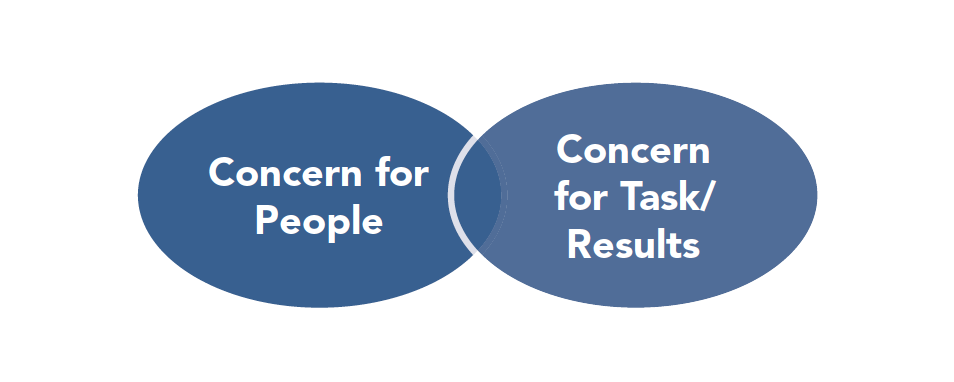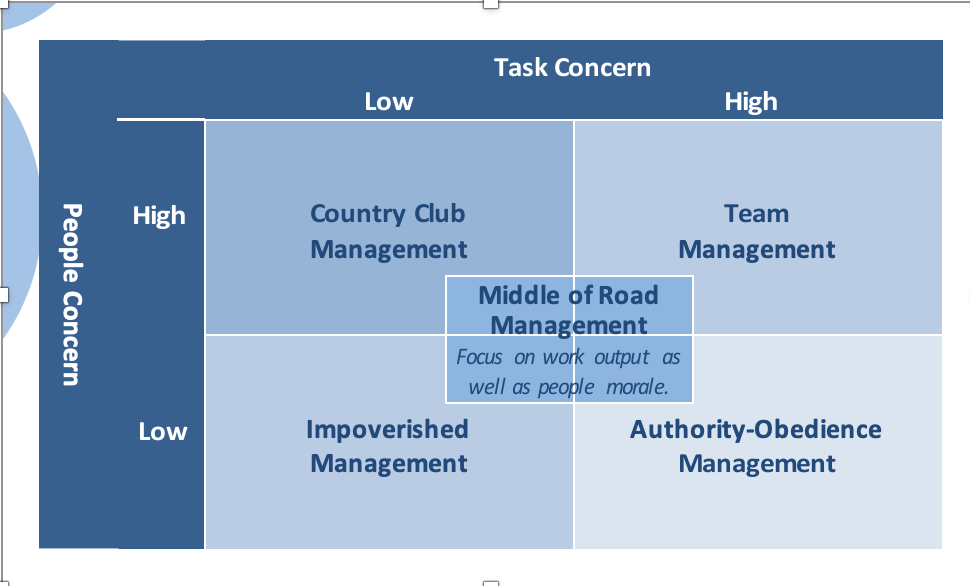Textbook Reading: Team FME - Blake-Mouton Managerial Grid
Blake-Mouton Managerial Grid
It’s no secret that there are a variety of different management and leadership styles out there. In fact, you could argue that there is a different managerial style for each individual person that serves in a leadership role.
The Blake-Mouton Managerial Grid is a system that can be used to group like leaders into categories based on the methods that they use.
While no organizational system will ever be perfectly complete,
this grid is a great way to understand more about certain
leadership styles and how they work. Dating back to the early 1960’s, this is a framework that has stood the test of
time and remains relevant today.
The two dimensions of this grid quickly identify the priorities of the manager in question— ‘Concern for People’ and ‘Concern for Results’. It doesn’t get much simpler than that, and it shouldn’t take long to determine where along this grid you fit as a leader.
● Concern for People. The leader that emphasizes Concern for People over Results is one who is trying to do their best to further the careers of those they are leading. As the decisions are being made regarding who will work on what parts
of a project. For example this leader is thinking before making assignments:
○ Which tasks will help each individual progress their careers?
○ Which tasks are likely to be enjoyed?
● Concern for Results. Naturally, this is the opposite of the previous approach. With this kind of leadership, the only concern is for the job getting done as successfullyas possible. This leader is one who sets aside any level of focus on the individuals and only things about the bigger picture for the organization. Whatever tasks need to be assigned to specific people in order to get the job done right is what
will be done. If the individuals within the group don’t like it, that will be their problem to deal with.

The real benefit of using the Blake-Mouton Managerial Grid comes when you start to look at it in terms of four quadrants, and what each of those means for the manager. When plotted on the grid based on the two dimensions, there are four possible quadrants that a management style.
● Impoverished Management—in this case, the manager is failing both in terms of the task and the people and is not a desirable position. The work isn’t being
completed successfully enough to satisfy the needs of the organization, and the individuals involved aren’t getting what they need out of it either.
This is a systemic failure, and will usually result in bad outcomes for the leader in question. Getting out of this quadrant as soon as possible should always be the goal of a manager who finds that they are failing on both fronts.
● Country Club Management—most employees will love their manager when this kind of system exists. The results may be suffering, and the manager’s superiors may not be impressed with their performance, but the employees are happy because they are being put first and having their needs met through the actions of the leader.
While the short-term results of this method may be enjoyable because the work environment is free of tension and conflict, the long-term results tend to be less benficial once the results come in and the group is falling short of expectations.
● Authority-Compliance Management—is the opposite of the Country Club management position. Instead of paying sole attention to the employees, this lead is only serving the needs of the project and the results they are looking for.
While they might reach the end goal, bridges could be burned in the meantime through the methods that are used. Unhappy employees tend to leave sooner, or decrease in production as their attitude drops. Short-term projects may benefit from this kind of strict management style, but it is unlikely to succeed over time.
● Team Management—offers the best of both worlds. This manager is able to successfully juggle the needs of the organization as a whole with the needs of the individual employees involved.
Of course, since this is the best model for most managers to strive for, it is also the most difficult to achieve. The needs of your employees might not always correlate with what the company is looking for, so getting those things to balance out and keep everyone happy is a battle that takes time and effort to win.
However, it will be worth the effort because the leader who is able to reach this quadrant of the grid is one that is likely to be well-received by his or her superiors for their work.
In the real world, things aren’t always as black and white as they can appear on a grid and managers often adopt the ‘Middle of the Road’ management approach. This means sometimes the focus is concentrated more on the task and at other times more on the people. Leadership styles and decisions take on many different shapes, and it isn’t always easy to decide how they fit into a certain mold.
The Blake-Mouton Managerial Grid is a good starting point for understanding the basic leadership options that a manager has when dealing with their employees. Avoiding the extremes and trying to balance all of the various interests at any one time is usually the best tact to take. Whether using the grid to evaluate yourself or someone else in your organization, it is a tool that remains useful decades after its creation.
Key POINTS
v" The Blake-Mouton Managerial Grid is a system that can be used to group like leaders into categories based on the methods that they use.
v" It uses a two dimensional grid to identify the priorities of the manager in question.
v" The axes are ‘Concern for People’ and ‘Concern for Results’ giving four possible quadrants that a management style can land in.
v" Impoverished Management—the manager is failing both in terms of the task and the people.
v" Country Club Management—employees are happy because they are being
put first and having their needs met through the actions of the leader.
v" Authority-Compliance Management—the manager is focusing too much on getting the task done at the expense of their team’s wellbeing.
v" Team Management—the manager is able to successfully juggle the needs of the organization as a whole with the needs of the individual employees involved.
